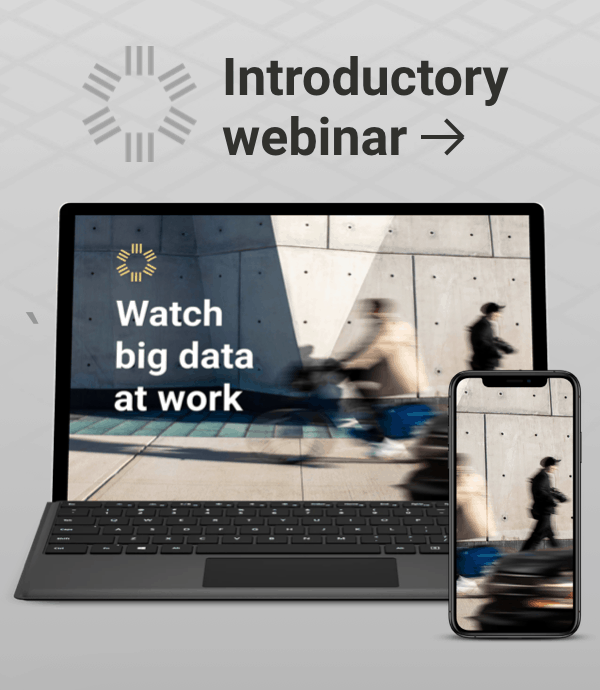
The Big Picture: Big Data for Detour Route Planning

If you’re like many drivers today, your heart sinks when you see an orange road sign with the word “DETOUR.” Suddenly, you remember the flashing highway sign that warned you in advance that construction was coming. In today’s busy world, you simply forgot and did not prepare. As you join the hundreds of other drivers who are now taking a circuitous journey around much-needed construction, you realize that you’re going to be late.
But with the right data tools, transportation planners can make these frustrating detour experiences much better. When planning major transportation projects such as construction and lane closures, it is essential to identify the best alternate routes to reduce traffic disruption – that’s something we can all understand. But it’s time to change the way we identify them. Learn more about using Big Data to improve detour planning in this blog post.
The Federal Highway Administration’s guide on “Developing and Implementing Transportation Management Plans for Work Zones” recommends that state agencies use simulations to analyze the impacts of work zones, but these simulations cost at least $150,000. They can also take several months to configure and run, and that’s after planners have collected the data they need to build these simulations. So while this tactic has been effective for planners, it is also a slow and arduous process. Sometimes planners don’t always have that time – just consider the collapse of a bridge on I-85 in Atlanta just a few months ago.
Big Data, defined here as location records from mobile devices, can be combined with contextual data sets to create powerful, accurate measurements of trip volume, peak travel times, and peak traffic flow. Even more importantly, they can show planners the origins and destinations of routes that will impacted by construction and closures. These analytics can help transportation planners develop more accurate detour scenarios that are grounded in real-world travel behavior much faster and cost-effectively.
Detour Templates Just Aren’t Enough
Prior to beginning construction, approved detour plans are required to help mitigate the impacts on roadways and the modified vehicular, bicycle, and pedestrian traffic. California’s Sacramento County, for example, provides planners with Traffic Control Plan templates. These templates help planners strategize an effective detour plan during construction. They offer suggestions for speed changes based on the project, appropriate signage for a detour, types of barricades, and more.
But even with 50 detailed scenarios for Sacramento alone, these templates do not cover all locations and situations that could occur. Exceptions require review and approval before construction can begin. Complex, multi-stage construction projects will likely require far more sophisticated solutions that are not offered on their website.


A Big Data Approach to Detour Planning
Big Data allows transportation engineers to quickly and easily estimate the impact of construction on travel patterns, and identify the most efficient alternative routes. The sample size from months of Big Data is usually superior to sending out a probe vehicle or scanning license plates, and it provides a more comprehensive picture of complete travel patterns than sensors.
This Big Data approach can also be used to optimize detour designs to help prevent bottlenecks and other unintended safety issues. Using this real-world data can help engineers to ensure that the alternate routes can handle the overflow traffic, preventing the many potential issues from the detoured traffic. Better measurement of existing travel patterns can also help reveal the routes that drivers prefer as alternatives, improving driver satisfaction and lessening potential disruptions or inconveniences.
Measuring Travel Patterns to Create Better Detours
Big Data makes it easier to measure corridor reliability and performance in a variety of conditions. For corridor studies using Big Data, transportation experts can zero in on the routes that travelers take to get from their origins to their destinations. They can quickly find out about the types of trips that take these routes at different times of day, types of day, and days of the year. Characteristics include:
- Average travel time
- Distributions of travel times
- Average speed
- Distributions of speeds
When transportation experts use analytics about trips from millions of mobile devices instead of relying on simulations alone, they can empirically measure the travel preferences of a far greater percentage of the population across a longer time span.
These analytics can also help planners target their communications about construction and road closures to the right audiences. When planners accurately identify where the origins and destinations of trips that use routes impacted by construction, they can ensure that the right people get the message about upcoming detours. While installing signage on the affected highways is an important first step, reaching out to employers and residents directly is equally valuable.
Beyond Detour Planning
For major transportation projects, traditional methods of data collection don’t always have the necessary detail to create dynamic responses to changing conditions. Armed with Big Data, transportation experts can develop a clear, comprehensive, description of behavior along specific corridors that is valuable for real-world projects. Because these expenditures are based on actual, measured behaviors, they are more likely to deliver good ROI in terms of both avoided congestion and dollars spent.